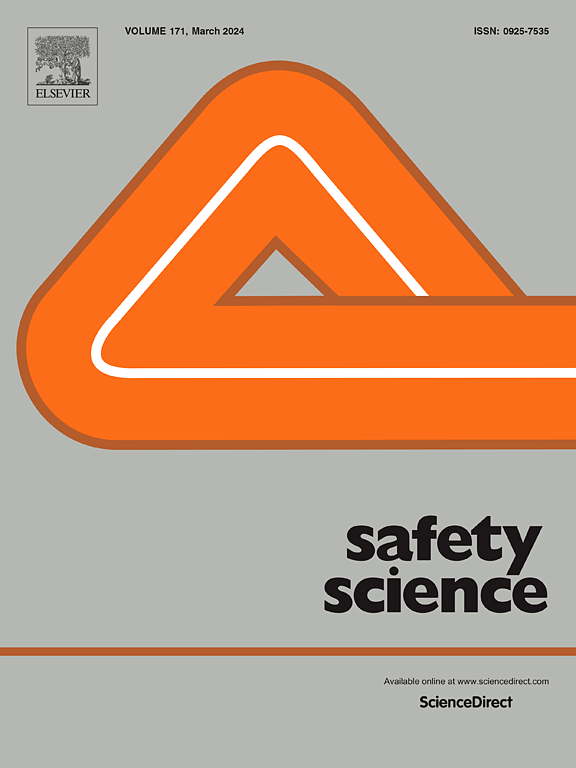A systematic review of hazard recognition and risk perception research in the construction industry
IF 5.4
1区 工程技术
Q1 ENGINEERING, INDUSTRIAL
引用次数: 0
Abstract
Hazard recognition and risk perception (HRRP) significantly contribute to construction workers’ risky behavior at work, guiding the development of effective safety management strategies. Research in this area spans various topics such as safety climate, risk-taking behavior, and safety training, presenting a diverse field of study. To provide an overview, we analyzed 232 HRRP articles published during the period from 2000 to May 2024 in Web of Science, Scopus, and ScienceDirect using bibliometrics and mapping knowledge domain approaches. This analysis identified three stages of research evolution: from early studies on accidents and behavior, to more focused HRRP investigations, and later expanding to broader safety considerations, including the integration of advanced technologies. Key publication sources include the Journal of Construction Engineering and Management, Safety Science, and Automation in Construction, contributing over 49% of total publications. China and the United States collectively contributed 71.55% of publications, with Tsinghua University leading in publications and North Carolina State University excelling in knowledge dissemination. Hong Kong Polytechnic University and King Saud University showed notable cooperation and citation performance. Influential scholars such as Albert, A., Li, H., and Alabdulkarim, S.A., are prominent in the field, demonstrating strong collaboration and citation impact. The co-occurrence network of author keywords revealed primary clusters focused on HRRP measurements, influential factors, risk-taking behavior impacts, and safety management. Future research directions include exploring failure mechanisms in HRRP, developing worker-centered safety training, advancing automated hazard identification, and expanding HRRP studies in developing countries.
建筑行业危害识别和风险感知研究的系统综述
危险识别和风险感知(HRRP)对建筑工人的危险行为有重要影响,指导制定有效的安全管理策略。该领域的研究涵盖了安全气候、冒险行为和安全培训等多个主题,呈现出一个多元化的研究领域。为了提供概述,我们使用文献计量学和知识图谱方法分析了2000年至2024年5月期间在Web of Science、Scopus和ScienceDirect上发表的232篇HRRP文章。该分析确定了研究演变的三个阶段:从早期对事故和行为的研究,到更集中的HRRP调查,再到后来扩展到更广泛的安全考虑,包括整合先进技术。主要出版物来源包括《建筑工程与管理杂志》、《安全科学》和《建筑自动化》,占总出版物的49%以上。中美两国共同贡献了71.55%的出版物,其中清华大学在出版物方面领先,北卡罗来纳州立大学在知识传播方面表现突出。香港理工大学和沙特国王大学表现出显著的合作和引文绩效。Albert, A., Li, H.和Alabdulkarim, sa .等有影响力的学者在该领域非常突出,表现出强大的合作和引用影响。作者关键词共现网络显示,主要聚类集中在HRRP测量、影响因素、冒险行为影响和安全管理方面。未来的研究方向包括探索HRRP的失效机制,发展以工人为中心的安全培训,推进自动化危险识别,以及扩大在发展中国家的HRRP研究。
本文章由计算机程序翻译,如有差异,请以英文原文为准。
求助全文
约1分钟内获得全文
求助全文
来源期刊

Safety Science
管理科学-工程:工业
CiteScore
13.00
自引率
9.80%
发文量
335
审稿时长
53 days
期刊介绍:
Safety Science is multidisciplinary. Its contributors and its audience range from social scientists to engineers. The journal covers the physics and engineering of safety; its social, policy and organizational aspects; the assessment, management and communication of risks; the effectiveness of control and management techniques for safety; standardization, legislation, inspection, insurance, costing aspects, human behavior and safety and the like. Papers addressing the interfaces between technology, people and organizations are especially welcome.
 求助内容:
求助内容: 应助结果提醒方式:
应助结果提醒方式:


